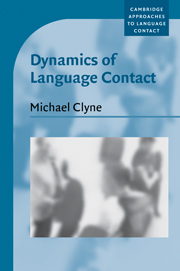Book contents
- Frontmatter
- Contents
- List of map and figures
- List of tables
- Series editor's foreword
- Acknowledgments
- List of abbreviations
- 1 Introduction
- 2 Dynamics of language shift
- 3 On models and terms
- 4 Dynamics of convergence and transference
- 5 Dynamics of transversion
- 6 Dynamics of plurilingual processing
- 7 Dynamics of cultural values in contact discourse
- 8 Towards a synthesis
- Notes
- References
- Index of authors
- Index of languages
- Index of subjects
7 - Dynamics of cultural values in contact discourse
Published online by Cambridge University Press: 18 December 2009
- Frontmatter
- Contents
- List of map and figures
- List of tables
- Series editor's foreword
- Acknowledgments
- List of abbreviations
- 1 Introduction
- 2 Dynamics of language shift
- 3 On models and terms
- 4 Dynamics of convergence and transference
- 5 Dynamics of transversion
- 6 Dynamics of plurilingual processing
- 7 Dynamics of cultural values in contact discourse
- 8 Towards a synthesis
- Notes
- References
- Index of authors
- Index of languages
- Index of subjects
Summary
Introduction
This chapter is intended to be exploratory. Up to now, the emphasis in this monograph has been on language itself, although the role of identity and ethnicity has arisen several times, especially in chapter 2. The present chapter will focus on those aspects of language contact which most closely reflect cultural values, identity change and multiple identity, again comparing the corpora of different community languages, vintages and generations.
Particular ways of addressing people in relation to culture-specific norms of politeness may be transferred from one language to another or they may be avoided by transversion, as will be illustrated from Vietnamese. The introduction or dropping of a whole set of discourse markers constitutes a move away from communicative behaviour according to the norms of the community language. The use of some examples of modal particles will be examined in our German, Dutch and Hungarian data, making comparisons where applicable across generations and vintages and between bi- and trilinguals. Then the same will be done for some discourse markers transferred from English, which may be transversion facilitating phenomena.
It is not always possible in this field to differentiate ‘language’ from ‘culture’ as a source of communicative behaviour, hence we will make use of Agar's (1994) notion of ‘languaculture’.
Pragmatic transference and code-switching to express pragmatic contrasts
In this section, address illustrates how pragmatic transference can lead to interlingual convergence and code-switching can reflect dual identity, the latter being supported by diminutive use.
- Type
- Chapter
- Information
- Dynamics of Language ContactEnglish and Immigrant Languages, pp. 215 - 233Publisher: Cambridge University PressPrint publication year: 2003



